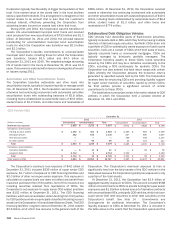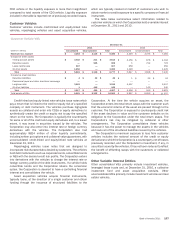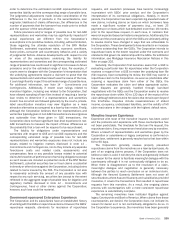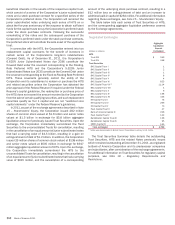Bank of America 2011 Annual Report Download - page 207
Download and view the complete annual report
Please find page 207 of the 2011 Bank of America annual report below. You can navigate through the pages in the report by either clicking on the pages listed below, or by using the keyword search tool below to find specific information within the annual report.Bank of America 2011 205
order to determine the estimated non-GSE representations and
warranties liability and the corresponding range of possible loss.
The judgmental adjustments made include consideration of the
differences in the mix of products in the securitizations, loan
originator, likelihood of claims differences, the differences in the
number of payments that the borrower has made prior to default
and the sponsor of the securitization.
Future provisions and/or ranges of possible loss for non-GSE
representations and warranties may be significantly impacted if
actual experiences are different from the Corporation’s
assumptions in its predictive models, including, without limitation,
those regarding the ultimate resolution of the BNY Mellon
Settlement, estimated repurchase rates, economic conditions,
home prices, consumer and counterparty behavior, and a variety
of judgmental factors. Adverse developments with respect to one
or more of the assumptions underlying the liability for
representations and warranties and the corresponding estimated
range of possible loss could result in significant increases to future
provisions and/or the estimated range of loss. For example, if
courts were to disagree with the Corporation’s interpretation that
the underlying agreements require a claimant to prove that the
representations and warranties breach was the cause of the loss,
it could significantly impact this estimated range of possible loss.
For additional information, see Note 14 – Commitments and
Contingencies. Additionally, if recent court rulings related to
monoline litigation, including one related to the Corporation, that
have allowed sampling of loan files instead of requiring a loan-by-
loan review to determine if a representations and warranties
breach has occurred are followed generally by the courts, private-
label securitization investors may view litigation as a more
attractive alternative as compared to a loan-by-loan review. Finally,
although the Corporation believes that the representations and
warranties typically given in non-GSE transactions are less rigorous
and actionable than those given in GSE transactions, the
Corporation does not have significant loan-level experience in non-
GSE transactions to measure the impact of these differences on
the probability that a loan will be required to be repurchased.
The liability for obligations under representations and
warranties with respect to GSE and non-GSE exposures and the
corresponding estimated range of possible loss for non-GSE
representations and warranties exposures does not include any
losses related to litigation matters disclosed in Note 14 –
Commitments and Contingencies, nor do they include any separate
foreclosure costs and related costs, assessments and
compensatory fees or any possible losses related to potential
claims for breaches of performance of servicing obligations (except
as such losses are included as potential costs of the BNY Mellon
Settlement), potential securities law or fraud claims or potential
indemnity or other claims against the Corporation, including claims
related to loans insured by the FHA. The Corporation is not able
to reasonably estimate the amount of any possible loss with
respect to any such servicing, securities law (except to the extent
reflected in the aggregate range of possible loss for litigation and
regulatory matters disclosed in Note 14 – Commitments and
Contingencies), fraud or other claims against the Corporation;
however, such loss could be material.
Government-sponsored Enterprises Experience
The Corporation and its subsidiaries have an established history
of working with the GSEs on repurchase claims. However, the GSEs’
repurchase requests, standards for rescission of repurchase
requests, and resolution processes have become increasingly
inconsistent with GSEs’ prior conduct and the Corporation’s
interpretation of its contractual obligations. Notably, in recent
periods, the Corporation has been experiencing elevated levels of
new claims, including claims on loans on which borrowers have
made a significant number of payments (e.g., at least 25
payments) or on loans which had defaulted more than 18 months
prior to the repurchase request, in each case, in numbers that
were not expected based on historical experience. Additionally, the
criteria and the processes by which the GSEs are ultimately willing
to resolve claims have changed in ways that are unfavorable to
the Corporation. These developments have resulted in an increase
in claims outstanding from the GSEs. The Corporation intends to
repurchase loans to the extent required under the contracts and
standards that govern its relationship with the GSEs. For additional
information, see Mortgage Insurance Rescission Notices in this
Note on page 202.
Generally, the Corporation first becomes aware that a GSE is
evaluating a particular loan for repurchase when the Corporation
receives a request from a GSE to review the underlying loan file
(file request). Upon completing its review, the GSE may submit a
repurchase claim to the Corporation. As soon as practicable after
receiving a repurchase claim from either of the GSEs, the
Corporation evaluates the claim and takes appropriate action.
Claim disputes are generally handled through loan-level
negotiations with the GSEs and the Corporation seeks to resolve
the repurchase claim within 90 to 120 days of the receipt of the
claim although tolerances exist for claims that remain open beyond
this timeframe. Disputes include reasonableness of stated
income, occupancy, undisclosed liabilities, and the validity of MI
claim rescissions in the vintages with the highest default rates.
Monoline Insurers Experience
Experience with most of the monoline insurers has been varied
and the protocols and experience with these counterparties has
not been predictable. The timetable for the loan file request, the
repurchase claim, if any, response and resolution vary by monoline.
Where a breach of representations and warranties given by the
Corporation or subsidiaries or legacy companies is confirmed on
a given loan, settlement is generally reached as to that loan within
60 to 90 days.
The Corporation generally reviews properly presented
repurchase claims from the monolines on a loan-by-loan basis. As
part of an ongoing claims process, if the Corporation does not
believe a claim is valid, it will deny the claim and generally indicate
the reason for the denial to facilitate meaningful dialogue with the
counterparty although it is not contractually obligated to do so.
When there is disagreement as to the resolution of a claim,
meaningful dialogue and negotiation is generally necessary
between the parties to reach conclusion on an individual claim.
Although the Assured Guaranty Settlement does not cover all
securitizations where Assured Guaranty and subsidiaries provided
insurance, it covers the transactions that resulted in repurchase
requests from this monoline. As a result, the on-going claims
process with counterparties with a more consistent repurchase
experience is substantially complete.
The remaining monolines have instituted litigation against
legacy Countrywide and Bank of America. When claims from these
counterparties are denied, the Corporation does not indicate its
reason for denial as it is not contractually obligated to do so. In
the Corporation’s experience, the monolines have been generally
























